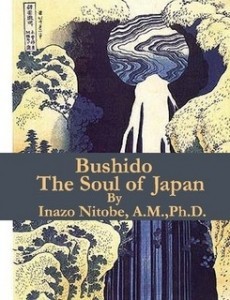
Bushido the Soul of Japan is is Inazo Nitobe‘s description of the Samurai code, Bushido. Bushido literally translates “the way of the warrior” and it was a widespread philosophy of work, war, art and spirituality which influenced the entire society. Bushido has it´s roots in Zen-Buddhism and the ethic codes of the Japanese chivalry and Bushido is a philosophical foundation for a range of martial arts such as Aikido and Kendo. Bushido the Soul of Japan was first published in 1904 and here it is:
 Bushido the Soul of Japan by Nitobe Inazo
Bushido the Soul of Japan by Nitobe Inazo
What is Bushido?
Bushido, often translated as “the way of the warrior,” is a unique code of conduct that held sway among samurai in feudal Japan, bearing a resemblance to the code of chivalry in medieval Europe. At its core, Bushido encompasses a range of moral principles that guided the samurai both on and off the battlefield.
Loyalty towards one’s master stood as a cornerstone of this ethos, defining the samurai’s social existence and martial allegiance. Coupled with this loyalty were the virtues of courage and rectitude, which empowered the samurai to face adversity with a fearless heart and to act with a sense of righteousness and justice.
Natural forces and ancestral spirits
Benevolence, politeness, honesty, honor, and self-control further refined the moral fabric of the samurai, shaping them into individuals of noble character and dignified conduct. These principles were not born in isolation but were significantly influenced by prevailing religious and philosophical currents. Confucianism, with its emphasis on loyalty, filial piety, and societal hierarchy, left a lasting imprint on the samurai ethos. Buddhism, particularly Zen Buddhism, enriched the samurai’s philosophical outlook, helping them grapple with the transient nature of life and the inevitability of death. Shinto, the indigenous spirituality of Japan, imbued the samurai with a profound reverence for natural forces and ancestral spirits.
The legacy of Bushido
The legacy of Bushido is captured and perpetuated through seminal texts like “Hagakure” and “Bushido: The Soul of Japan” by Inazo Nitobe. These writings have not only documented but also propagated the ethos of Bushido beyond the shores of Japan. Today, Bushido continues to resonate in the realm of martial arts and extends its influence into broader ethical and cultural discussions in Japan. Modern interpretations, albeit romanticized at times, have rekindled interest in Bushido, making it a subject of both historical inquiry and cultural fascination. While it’s celebrated for its idealized virtues, some scholars caution that the historical reality of Bushido may have been more nuanced, with the principles of the code perhaps not as uniformly adhered to by the samurai of yore as often depicted. Through the lens of Bushido, one glimpses the complex interplay of historical, social, and philosophical forces that have indelibly shaped Japan’s martial tradition and cultural identity.

